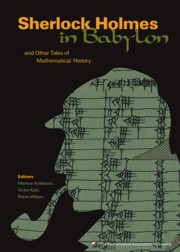Book contents
- Frontmatter
- Introduction
- Contents
- Ancient Mathematics
- Medieval and Renaissance Mathematics
- The Seventeenth Century
- Foreword
- An Application of Geography to Mathematics: History of the Integral of the Secant
- Some Historical Notes on the Cycloid
- Descartes and Problem-Solving
- René Descartes' Curve-Drawing Devices: Experiments in the Relations Between Mechanical Motion and Symbolic Language
- Certain Mathematical Achievements of James Gregory
- The Changing Concept of Change: The Derivative from Fermat to Weierstrass
- The Crooked Made Straight: Roberval and Newton on Tangents
- On the Discovery of the Logarithmic Series and Its Development in England up to Cotes
- Isaac Newton: Man, Myth, and Mathematics
- Reading the Master: Newton and the Birth of Celestial Mechanics
- Newton as an Originator of Polar Coordinates
- Newton's Method for Resolving Affected Equations
- A Contribution of Leibniz to the History of Complex Numbers
- Functions of a Curve: Leibniz's Original Notion of Functions and Its Meaning for the Parabola
- Afterword
- The Eighteenth Century
- Index
- About the Editors
Some Historical Notes on the Cycloid
from The Seventeenth Century
- Frontmatter
- Introduction
- Contents
- Ancient Mathematics
- Medieval and Renaissance Mathematics
- The Seventeenth Century
- Foreword
- An Application of Geography to Mathematics: History of the Integral of the Secant
- Some Historical Notes on the Cycloid
- Descartes and Problem-Solving
- René Descartes' Curve-Drawing Devices: Experiments in the Relations Between Mechanical Motion and Symbolic Language
- Certain Mathematical Achievements of James Gregory
- The Changing Concept of Change: The Derivative from Fermat to Weierstrass
- The Crooked Made Straight: Roberval and Newton on Tangents
- On the Discovery of the Logarithmic Series and Its Development in England up to Cotes
- Isaac Newton: Man, Myth, and Mathematics
- Reading the Master: Newton and the Birth of Celestial Mechanics
- Newton as an Originator of Polar Coordinates
- Newton's Method for Resolving Affected Equations
- A Contribution of Leibniz to the History of Complex Numbers
- Functions of a Curve: Leibniz's Original Notion of Functions and Its Meaning for the Parabola
- Afterword
- The Eighteenth Century
- Index
- About the Editors
Summary
Introduction
In this paper our interest is not in a renowned mathematician, a celebrated school, or a famous problem, but in a curve, the cycloid. More particularly, our interest is to center around its relation to the mathematics of the seventeenth century, one of the great centuries in the history of the subject. This curve had the good fortune to appear at a time when mathematics was being developed very rapidly and perhaps mathematicians were fortunate that so useful a curve appeared at this time. A new and powerful tool for the study of curves was furnished by the analytic geometry, whose year of birth is commonly given as 1637. New methods for finding tangents to curves, the areas under curves, and the volumes of solids bounded by curved surfaces were being discovered at a rapid pace, and a new subject, the calculus, was in the making. In these developments the cycloid was the one curve used preeminently and nearly every mathematician of the time used it in a trial of some of his new theory, even to the extent that much of the early histories of analytic geometry, calculus, and the cycloid are closely interwoven.
In the history that follows we shall not be concerned with historical minutiae, but only with the broad outlines of the story of this curve.
Early history of the curve
The original discoverer of the cycloid appears to be unknown.
- Type
- Chapter
- Information
- Sherlock Holmes in BabylonAnd Other Tales of Mathematical History, pp. 183 - 187Publisher: Mathematical Association of AmericaPrint publication year: 2003
- 1
- Cited by

